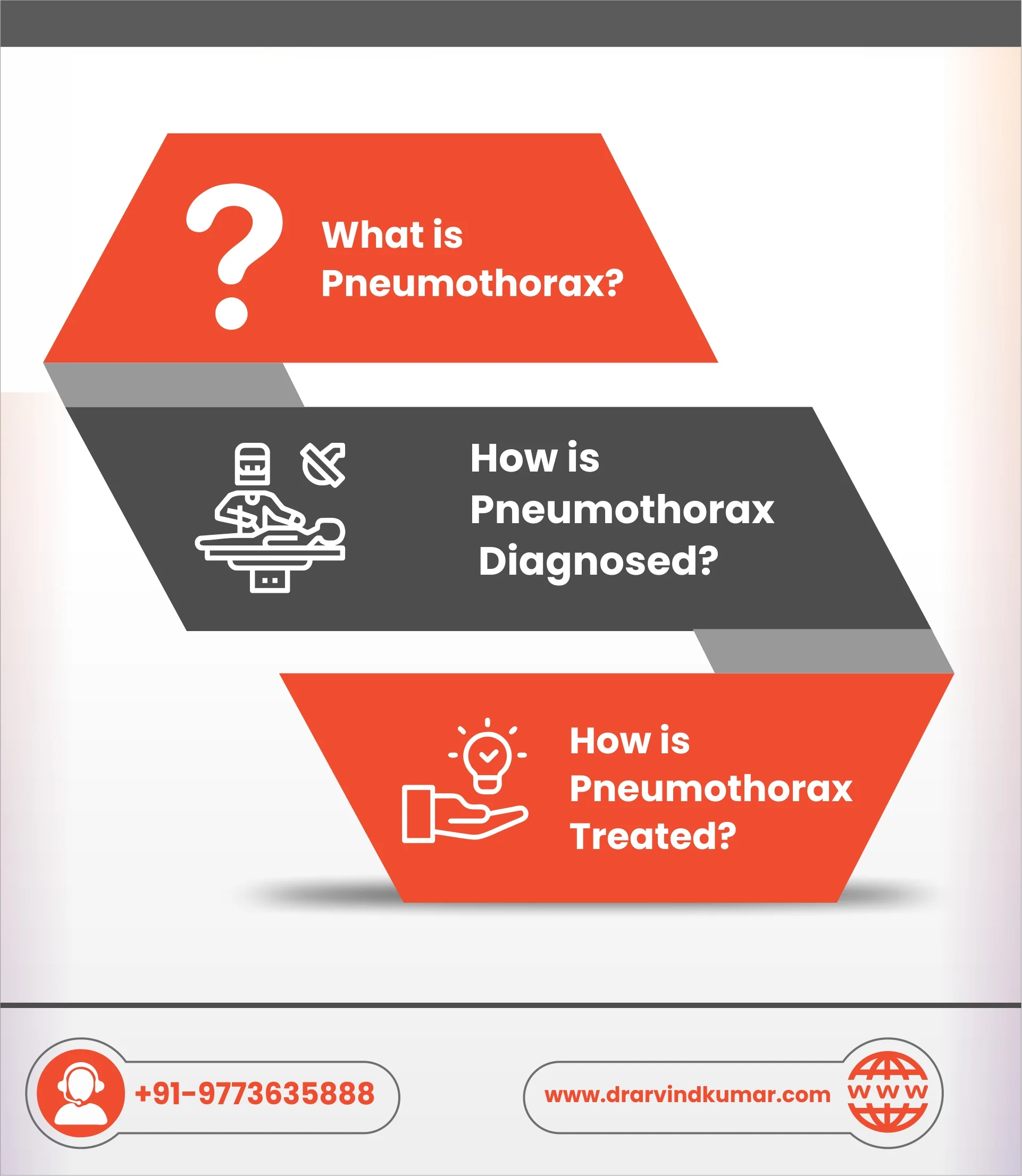Experiencing pneumothorax or lung collapse could be a sign of lung disease or due to some kind of underlying or chronic disease that is either diagnosed or undiagnosed. The collapse could also be due to a chest injury or idiopathic (where the cause is unknown).
Irrespective of the symptoms, pneumothorax is a condition that requires immediate medical attention, especially in patients with a medical history of lung complications. The symptoms of the condition involve chest pain, shortness of breath, etc.
Awareness of the right pneumothorax treatment is essential to ensure that the patient gets immediate medical care following a confirmed diagnosis.
What is Pneumothorax?
Pneumothorax, as we just mentioned, is the condition of collapsed lung/s. It happens when the air leaks into the chest cavity instead of staying contained inside the lungs. The excess air between the lungs and chest wall creates excess pressure, pushing against the lung/s and causing its collapse.
The pneumothorax condition can either lead to a complete lung collapse, affecting the function of whole lung, or it could lead to partial lung collapse, leading to the collapse of a part of the lung.
The common symptoms include sharp, stinging, sudden chest pain, and shortness of breath. Although not always, pneumothorax could be fatal in some conditions.
If the chest pain and discomfort worsen progressively, seeing a doctor is an absolute must. Additionally, if you have a history of lung disease and/or are on medications for it, getting immediate medical help is crucial.
How is Pneumothorax Diagnosed?
Pneumothorax treatment is entirely reliant on the diagnosis of the patient. Depending on the symptoms, the only accurate way to diagnose a potential pneumothorax is with imaging tests.
X-ray and CT-scan are considered the most effective diagnosis route for a patient with a case of pneumothorax.

How is Pneumothorax Treated?
When you visit your doctor with signs and symptoms of Pneumothorax, their first line of action is to confirm a diagnosis.
Following that, the second step in the treatment is to analyze the best route of action to relieve the pressure that’s being imposed by the air on the lung/s. Relieving the pressure enables the lungs to re-expand, fill them with air, and ensure the patient can breathe normally again.
Depending on the cause of the pneumothorax, the doctor might involve treatment to prevent a similar complication. Treatment options for pneumothorax entirely depend on the pneumothorax complications in the patient and their overall physiological well-being.
There are three routes of treatment for pneumothorax. Let us discuss them in detail:
1. Simple Observation
This particular treatment route is effective in patients with partial lung collapse. If the damage isn’t too much and the patient isn’t experiencing any drastic symptoms affecting their quality of life, the doctor keeps the patient under strict and frequent observation.
During this, the patient needs to get a routine chest X-ray to track the progress of recovery. The primary objective of the “observation” is to wait until the excess air between the lungs and chest wall is automatically re-absorbed into the bloodstream and the lung re-expands to its normal size.
Self-recovery and this observation period aren’t a one-day thing. It can easily take a few weeks for complete recovery, which is one of the reasons why Dr. Arvind explains to the patients about the dos and don’ts during this period of recovery.
2. Needle Aspiration or Chest Tube Insertion
If the pneumothorax has led to the collapse of a large part of the lung.
A chest tube for pneumothorax is a procedure in which a flexible chest tube is inserted into the area with excess air. The other end of the chest tube is connected to an underwater device, which removes the air consistently from the chest cavity, thereby causing the lungs to re-expand.
Needle aspiration, on the other hand, involves the insertion of a needle attached to a catheter into the air-filled space. Once the needle has been placed in the air-filled area, the doctor removes the needle and connects the catheter to a syringe to draw out the excess air from the chest cavity to let the lungs re-expand and function normally.
3. Surgical Interventions
In patients with pneumothorax, where Lung doesn’t expand after chest tube insertion or there is persistent leakage of air beyond 5-7 days after Chest tube insertion, the only effective treatment route is to fix the issue with surgery.
The surgery, in most cases, is done via a minimally invasive procedure (VATS) by making a small incision and using a camera to venture into the chest cavity to find the source of the air leak and fix it using long-handled surgical tools (staplers).
We have done a large number of such operations by VATS, with excellent outcomes.
Conclusion
Managing pneumothorax could be a life-long process. Your doctor will advise you to avoid smoking, lead an active lifestyle, eat a healthy diet, etc., to prevent any kind of recurrence of the condition.
At Medanta, Dr. Arvind Kumar and his team offer holistic and comprehensive pneumothorax treatment with surgical and non-surgical repairs. If you are experiencing symptoms of pneumothorax that are progressively worsening, we’d recommend scheduling a consultation for further medical guidance.
For more details, visithttps://drarvindkumar.com/contact-us.php.
FAQs
Is pneumothorax surgery safe?
Opting for pneumothorax surgery is often effective, with a high survival rate for the patient after the surgery. It is often the most common route of treatment for elderly patients.
What is the average recovery time for a pneumothorax?
Pneumothorax recovery depends on the extent and severity of the condition. In patients with a small leak, the recovery can occur on its own and within 1-2 weeks. However, patients with large air leaks might need surgical repairs, which involve a longer recovery period.
Is pneumothorax life-long?
Pneumothorax, although common, isn’t always life-threatening. It depends on the air leak size and the patient’s medical history.

.webp)



